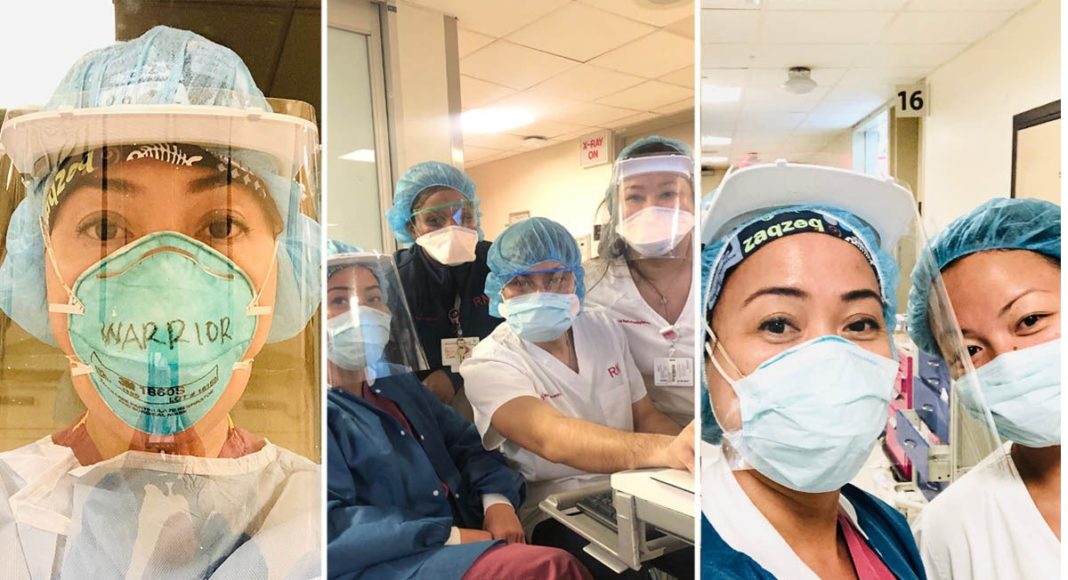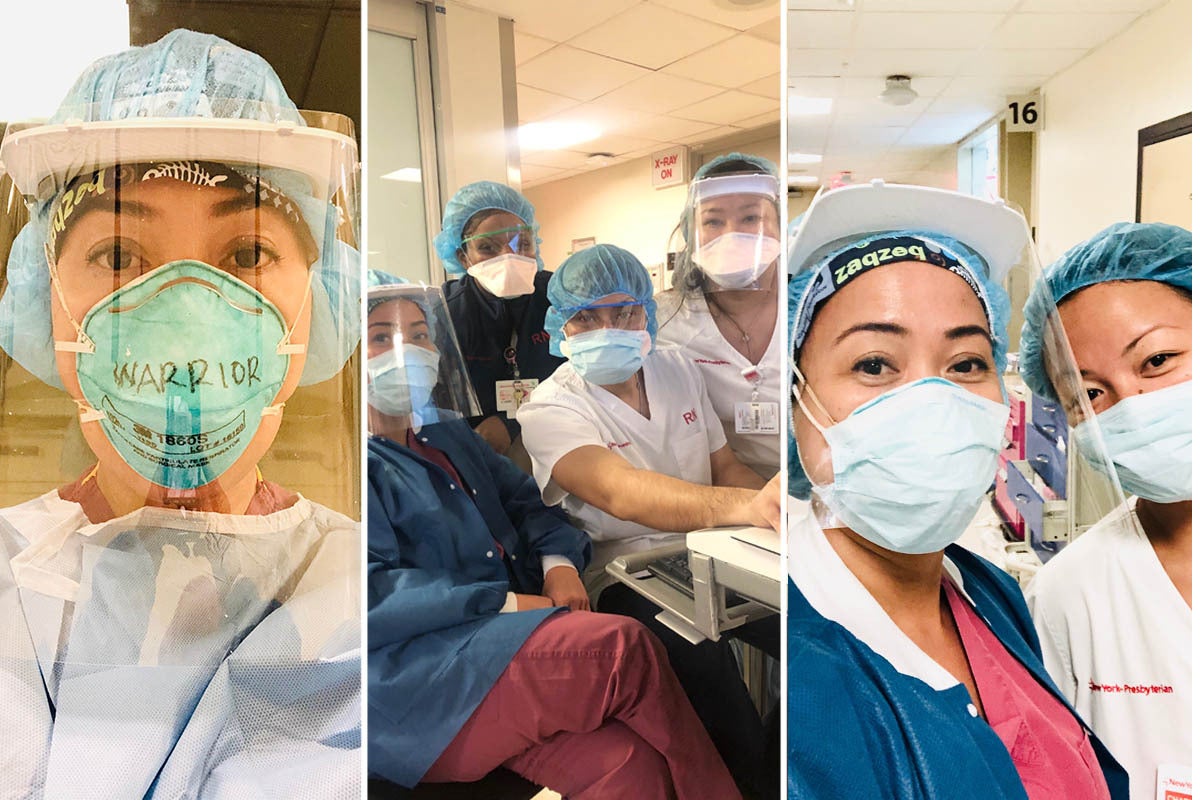Christianne Calderon leaves her New Jersey home just as the sun begins to set, and makes her way to the hospital where she works in Manhattan to work the nightshift.
She says goodbye to her children, and puts on the mask she has worn for weeks. Across the front, she has written the word “warrior” — in recognition of the battle she fights every day on the frontline of the coronavirus outbreak.
Download the new Independent Premium app
Sharing the full story, not just the headlines
Download now
“I wrote warrior on there because we are facing a war,” she says. “We are fighting an unknown, invisible and unpredictable enemy. Everybody is in fight mode. All of the doctors, nurses, everybody.”
As a nurse practitioner in an intensive care unit in New York, Calderon is at the epicentre of America’s deadly outbreak. The city has reported more than 43,000 coronavirus cases and 932 deaths as of Tuesday. Hospitals here have become overwhelmed and are running out of equipment.
In an interview with The Independent, she gives a harrowing account of the scale of the crisis facing medical staff in the city, and the personal toll it is taking on her and her family.
“I’ve worked in New York for 15 years in the intensive care unit, and I’ve never seen anything like it. I feel like I’m in a foreign country,” she says. “This week was just tremendously overwhelming and difficult, both physically and emotionally.”
left
Created with Sketch.
right
Created with Sketch.
1/26
An empty street in Manhattan borough following the outbreak of coronavirus disease in New York City
Reuters
2/26
A cab drives down at Seventh Avenue in Times Square
Reuters
3/26 Manhattan
Reuters
4/26
Syracuse University campus is seen almost empty as number of universities are moving all classes to e-learning, due to the coronavirus outbreak
Reuters
5/26 Manhattan
Empty street is seen near Lincoln tunnel
Reuters
6/26 Manhattan
An empty restaurant
Reuters
7/26 Manhattan
Reuters
8/26 Manhattan
Reuters
9/26 Manhattan
Empty chairs are seen near Hudson yards
Reuters
10/26 Manhattan
Reuters
11/26 Manhattan
An empty restaurant
Reuters
12/26
A mobile souvenir shop sits in an empty parking lot at Allianz Field as a match between the New York Red Bulls at Minnesota United FC is postponed
USA Today Sports/Reuters
13/26 Manhattan
Reuters
14/26 Manhattan
An empty Jacob K Javits Convention Center
Reuters
15/26 Syracuse University
A person sits in an empty eating hall
Reuters
16/26 Manhattan
Empty parking lots
Reuters
17/26 Manhattan
Reuters
18/26 Manhattan
Jacob K Javits Convention Center
Reuters
19/26 Seventh Avenue
Reuters
20/26 Manhattan
Reuters
21/26 Manhattan
Reuters
22/26 Manhattan
Reuters
23/26 Manhattan
Empty retail stores
Reuters
24/26 Manhattan
Empty street is seen outside the New York Times building
Reuters
25/26 Manhattan
Empty parking lots
Reuters
26/26 Manhattan
Reuters
1/26
An empty street in Manhattan borough following the outbreak of coronavirus disease in New York City
Reuters
2/26
A cab drives down at Seventh Avenue in Times Square
Reuters
3/26 Manhattan
Reuters
4/26
Syracuse University campus is seen almost empty as number of universities are moving all classes to e-learning, due to the coronavirus outbreak
Reuters
5/26 Manhattan
Empty street is seen near Lincoln tunnel
Reuters
6/26 Manhattan
An empty restaurant
Reuters
7/26 Manhattan
Reuters
8/26 Manhattan
Reuters
9/26 Manhattan
Empty chairs are seen near Hudson yards
Reuters
10/26 Manhattan
Reuters
11/26 Manhattan
An empty restaurant
Reuters
12/26
A mobile souvenir shop sits in an empty parking lot at Allianz Field as a match between the New York Red Bulls at Minnesota United FC is postponed
USA Today Sports/Reuters
13/26 Manhattan
Reuters
14/26 Manhattan
An empty Jacob K Javits Convention Center
Reuters
15/26 Syracuse University
A person sits in an empty eating hall
Reuters
16/26 Manhattan
Empty parking lots
Reuters
17/26 Manhattan
Reuters
18/26 Manhattan
Jacob K Javits Convention Center
Reuters
19/26 Seventh Avenue
Reuters
20/26 Manhattan
Reuters
21/26 Manhattan
Reuters
22/26 Manhattan
Reuters
23/26 Manhattan
Empty retail stores
Reuters
24/26 Manhattan
Empty street is seen outside the New York Times building
Reuters
25/26 Manhattan
Empty parking lots
Reuters
26/26 Manhattan
Reuters
The 40-year-old mother-of-two oversees a team of nurses in an intensive care unit at New York’s Presbyterian Hospital-Columbia University. Patients are brought to her from the emergency department in critical condition, usually attached to a ventilator. The past week has pushed her facility close to capacity.
“Someone is dying in our unit every day,” she says. “I have four patients. Just the other day before I left somebody died. And I was just told that another patient died this morning. Those are just my patients.”
“It’s just wall-to-wall Co cases. They are all intubated, they have a ventilator and many of them are on dialysis,” she says.
Much of New York’s crisis is playing out behind hospital doors, out of sight — but small clues to its scale are inescapable. In Central Park, an emergency field hospital has been constructed by Samaritan’s Purse, a Christian NGO that works in war zones across the world. Makeshift morgues made from white tents have appeared outside hospitals, along with refrigerated trucks to store the expected waves of dead. Ambulances line up on the street outside of emergency rooms, waiting for their turn to offload patients. At night, their sirens echo through the empty streets.
No hype, just the advice and analysis you need
The sheer number of patients seeking medical care has overwhelmed hospitals, but they have been put under even more stress by staff falling ill after contracting the virus.
Last week, a nurse at Mt Sinai West hospital died after contracting the coronavirus. Colleagues of Kious Kelly, a 48-year-old assistant nurse manager who lost his life, had complained that they were not being proed with the proper protective equipment in the days before his death.
Read more
Three of Calderon’s colleagues are currently receiving treatment for the coronavirus — a surgeon, a nurse and an anaesthesiologist. Two of them have received treatment in her unit.
“It’s heartbreaking. I’ve worked with all three of them and they’re now our patients. That’s sort of your family, and they’re here. Typically the people you take care of are strangers. Now it’s somebody that you know, someone that you work alongside with and it hurts,” she says.
Calderon’s husband is also a nurse, but he is now sick and staying with his parents. Her mother, a retired nurse, has been helping out. Like thousands of medical professionals across the city, every part of her life has been turned upside down by the outbreak.
There are the daily difficulties faced by many other parents during the pandemic — with schools closed, Calderon is responsible for homeschooling her children when she gets back from her 12 hour night shift.
And then there are a whole other set of problems related to her job. For one, she lives with the constant fear of carrying the virus home with her and infecting her children. To protect them, she has had to adapt her homelife, separating herself as much as possible.
“Everything comes off once I come home by the door. I run to the bathroom, I shower from head to toe and then I put my clothes on and I put my mask on,” she says.
“I hugged my children on that first night before going in, because I knew I wasn’t going to be able to hug them again for a while. I have to keep my distance from them.
Calderon’s eight-year-old daughter used to sleep in her bed with her when her husband worked nights, but now she can’t. She makes both of her kids wear masks at home, too.
“I have no choice, I don’t have anywhere else to stay. I don’t have a garage to camp in. If I were able to stay away, I would.”
The risks she faces every day has forced her to make contingency plans should the worst happen.
“We’ve talked about end of life for me. These are conversations that are difficult to have, but I know my role, I know my obligation and I know what I signed up for,” she says.
And yet, despite her years of experience in dealing with the critically ill patients, there is something different about what she is facing now. Calderon has dealt with dying patients before, but never has she had to see so many people die alone.
“What I found most difficult this week was talking to the families of these patients,” she says.
“These patients are alone. They don’t have their families with them. I always get the question: ‘Can I visit?’ And I have to say: ‘No you cannot, but I’m here. I’m here for the next 12 hours. If you have to call, whatever questions that come to your mind, I will try my best to answer and you can find me.’”
“I hear them crying. They are asking for a promise that I can’t give and it’s hard for me. I feel devastated and frustrated for them. I’m pained by that,” she says.
There are times in the intensive care unit when, inevitably, it becomes too much to bear.
“I can tell you that I’ve had to cry in silence, or cry on my own where nobody sees me. I cry when I get home. I’m pleading with God, you know, there’s so many good people, please don’t take them away.”
On Tuesday, New York governer Andrew Cuomo summed up the mood of many when he conceded that it could be weeks before the worst of the pandemic hits the state.
“We’re all anxious, we’re all tired, we’re all fatigued. It’s been all bad news for a long time. Our whole lifestyle has been disrupted. Everybody wants to know one thing, when will it end. Nobody knows,” he said. “We’re dealing with a war we’ve never dealt with before. We need a totally different mindset and organisational transformation.”
Mr Cuomo has drawn praise from New Yorkers for his handling of the crisis, including from Calderon. But, she says, the federal government is another story. President Donald Trump this week publicly questioned why New York needed thousands of protective masks, and insinuated that hospitals were hoarding them, without eence.
Watch more
“I want them to witness what we are going through. Someone to see just even an hour of our shift. Perhaps it will motivate them to facilitate and expedite sending help in whatever we need — ventilators, staff, more protective equipment,” she says.
“And that’s just work. Most of us have families, children to care for. I consider myself lucky to have my mother to watch my children while I work, but many don’t have that luxury.”
But as difficult as battling the coronavirus is, for Calderon, being away from the fight is even worse. Recently she was forced to self-isolate after coming into contact with a colleague who had tested positive. She was away from the hospital for a week.
“I felt extremely guilty that I wasn’t on the frontline, among the other healthcare workers that I work with, that I wasn’t there.
“Even though it’s hard for me, I still want to go back. I’m driven to fight it, if it takes for me to cry every single minute, I will. Even if I don’t eat, don’t drink, I will go back. I don’t want to be home when everybody else is fighting.”




